Page contents
- Introduction
- Phase 1 – what you told us last time
- Local Plan Phase 2 – what we want to do
- What is renewable energy?
- How much renewable energy do we need to generate?
- What opportunity is there for renewable energy generation in South Gloucestershire?
- General principles
- Solar energy
- Wind energy
- Community energy proposals
Introduction
In July 2019, South Gloucestershire Council declared a Climate Emergency. This acknowledged the need to urgently prepare for the local impact of climate change, reduce our carbon emissions, significantly increase renewable energy generation and protect and restore nature. As part of this, the Council has pledged to provide the leadership to enable South Gloucestershire to become carbon neutral by 2030.
An important part of th is response, as set out in our Phase 1 consultation document, will be brought forward through our Local Plan which will seek to ensure growth and development support sustainability, our environment and benefit current and future residents and businesses.
Phase 1 – what you told us last time
Through the Phase 1 consultation document, we shared a new draft policy in relation to renewable and low carbon energy systems and asked some key questions in relation to our proposed approach. Much of the feedback received relates more to policy areas that are being developed for future stages of the Local Plan, including in relation to energy management in new development.
The draft policy was seeking to require all new development to be net zero carbon and included:
- minimising energy demand;
- incorporating sources of renewable heat;
- meet cooling demand sustainably; and
- maximising on-site renewable energy generation, e.g. rooftop solar and other technologies.
A summary of the feedback received specifically in relation to our proposed approach to new, standalone renewable energy development is set out below:
- it is appropriate for the council to show leadership and where possible, support communities to bring forward renewable energy generation.
- renewable energy generation is important and will bring environmental and economic benefits.
- subject to further consideration and development of detailed policy criteria, there was broad consensus that the proposed approach, which included identifying suitable areas for renewable energy and safeguarding land, was appropriate
- allied to this, further detail is needed on the process by which land or sites would be safeguarded through the Local Plan
View all the responses to our consultation on these issues
Local Plan Phase 2 – what we want to do
An important part of climate change mitigation involves achieving 100% renewable energy across all sectors. The Council is therefore seeking to significantly increase the amount of renewable energy generated in South Gloucestershire.
The new Local Plan is a key tool to achieve this, and new approaches and planning policies will need to be developed.
At this stage, we are starting to think about how we can develop a positive strategy for renewable energy generation in South Gloucestershire. An important part of doing this will involve directing development of standalone wind and solar renewable energy installations to specific areas and in some cases safeguard land to facilitate delivery.
Through this consultation, we want to start sharing and discussing options around where these areas might be located. This will help inform future consideration of which areas we should identify and safeguard for renewable energy development through our Policies Map.
In considering this issue, it is worth noting the important role of other technologies, including the Government’s ambitious commitment to delivering offshore wind, which is very much supported. It is however widely acknowledged, including in national policy, that this is only part of the solution and there remains a need for us to significantly increase onshore renewable energy generation in South Gloucestershire too.
What is renewable energy?
The term ‘renewable energy’ covers those energy flows that occur naturally and repeatedly in the environment – from the wind, the fall of water, the movement of the oceans, from the sun and also from biomass and deep geothermal heat (National Planning Policy Framework). It produces little or no net carbon dioxide, which is one of the main greenhouse gas emissions that causes anthropogenic climate change.
For the purposes of this part of the Local Plan, our focus is primarily on wind and solar renewable energy because:
- our evidence also shows that standalone wind and solar photovoltaic (ground mounted) technologies are the cornerstone of any renewable energy strategy
- these resources provide the most opportunities in South Gloucestershire, compared to other resources such as hydropower
- they are a ‘mature’ technology in that they are technically well developed, widely used globally and cost effective, and can be deployed rapidly
- they have the most significant spatial implications of all types of renewable energy generating development
- this is consistent with existing national policy and the Government’s recently published Net Zero Strategy
- the council, as the local planning authority, can play an important role in their delivery
For these reasons, we consider it is appropriate and necessary for wind and solar renewable energy generating development be considered through the Local Plan process alongside other important land-use related issues.
In addition to this, and to ensure that a holistic approach is taken towards our energy system in the Local Plan, the Renewable Energy Resource Assessment Study (RERAS) we commissioned also covers other sources of renewable energy (such as biomass) and low carbon technologies (such as storage and hydrogen) which can support a renewable energy-based system and help decarbonise different sectors. The RERAS was commissioned, working with our partners (Bath and North East Somerset, North Somerset and the West of England Combined Authority (WECA)) to ensure a consistent approach across those areas.
We are also continuing to work with our partners on evidence to support policies which will ensure all new built development (both residential and non-residential) is net zero carbon, minimises energy demand and incorporates renewable energy (both heat and power) technology within it and to explore opportunities for district heat networks. We are also progressing other interventions outside of the planning system which seek to incentivise and bring forward opportunities for roof top solar PV on existing buildings, including homes, community buildings, schools and industrial or commercial premises.

Nuclear fusion is also referred to in the RERAS and has a potentially significant role to play in producing energy in South Gloucestershire and the UK’s future energy system.
This form of low carbon energy generation is of particular interest locally, due to the recent bid by the Western Gateway (cross-border economic partnership, which the Council is a partner in) for a technology park and fusion power plant be located at two former nuclear power station sites one in our area at Oldbury on Severn, and part of the facility in Berkeley (nearby in Stroud District). The bid correlates with the Government’s Ten Point Plan for a Green Industrial Revolution which outlines the aim to build the world’s first commercially viable fusion power plant in the UK by 2040.
Although the potential delivery of a fusion power plant at Oldbury may not be completed within the Local Plan period, the long-term positive contribution it could make to meeting UK energy needs make it a significant project.
We think that all the technologies referred to above will play an important role in boosting energy supply going forward. Notwithstanding this, we do however think it is important that at this stage we focus on setting a positive strategy for standalone solar and wind renewable energy generation through our Local Plan (for the reasons set out above) and to progress towards our Climate Emergency aims, which can be achieved with certainty during our new Local Plan 20 year period.
Further information can be found in the RERAS Report (under Renewable and low carbon energy).
How much renewable energy do we need to generate?
There is no prescribed way of determining how much energy should be generated from installations located within South Gloucestershire. However, in order to explore the implications of our Climate Emergency 2030 target on renewable energy development and to provide an indication of the scale of the challenge, we have explored this issue through our evidence base, specifically the RERAS. As part of this, we have projected local energy demand in South Gloucestershire in 2030 based on the assumption that we are living in a carbon neutral scenario.
The RERAS therefore presents a ‘snapshot’ theoretical projection of local energy demand in 2030 in terms of Gigawatt hours (circa 3500GWh), and it is based on a number of assumptions:
- by 2030, total overall energy demand (heat and power) is expected to reduce significantly (up to 50%) due to accelerated progress with home energy efficiency improvements, technology efficiency improvements, and changes in consumer behaviour
- action is needed (in addition to the Local Plan) to help make these progressive assumptions occur, and the Council is playing its part in this through its wider Climate Emergency response
- it is expected that the proportion of total energy demand that is met by electricity is going to increase significantly (circa 250%), due to switching fuel for heating and transport to electricity
In the RERAS, the electricity element (2977GWh) of the projected 2030 local energy demand has been translated into potential scenarios of what it could actually mean on the ground in terms of the number and mix of additional solar and wind renewable energy installations in South Gloucestershire. The scenario presented in the RERAS that best aligns with the Climate Emergency 2030 target is depicted below. This equates to all our projected 2030 annual local electricity demand being met from renewable energy generated from installations located in South Gloucestershire.
Further information can be found in the RERAS Report (under Renewable and low carbon energy).

Amount of renewable energy generated at present
The estimated annual renewable energy generation in South Gloucestershire at September 2020 was 260 GWh. However, this figure will vary year on year depending on the weather, and other factors.
Since then, a number of other schemes have been given planning permission, which are not yet operational, but should be by 2030. According to our evidence, this means that if we include these, the estimated annual renewable energy generation will be 333 GWh.
We currently monitor the proportion of local energy demand that is theoretically met from installations within South Gloucestershire, to track our annual progress on generating renewable energy. This is reported in our Annual Renewable Energy Progress Report.
Understanding the challenge
To put the units referred to above into context, 1 gigawatt hour (GWh) is 1,000 megawatt hours (MWh), which is 1,000,000 kilowatt hours (KWh).
In order to aid understanding of the amount of electricity this relates to:
- A one bar electric fire will use 1kWh of electricity during one hour, so 1GWh of electricity could run a one bar electric fire for 1 million hours/ 114 years/ 1 million electric fires for 1 hour
- 1GWh of electricity could run 110 million LED lights for one hour
- 1GWh of electricity would keep the UK operating for 110 seconds on average. On average the UK uses about 0.55GWh of electricity every minute
- 1GWh of electricity could boil an average kettle 10 million times
- 1GWh would supply 345 medium houses for a year (1,000,000 KWh / 2900 kWh) according to Ofgem
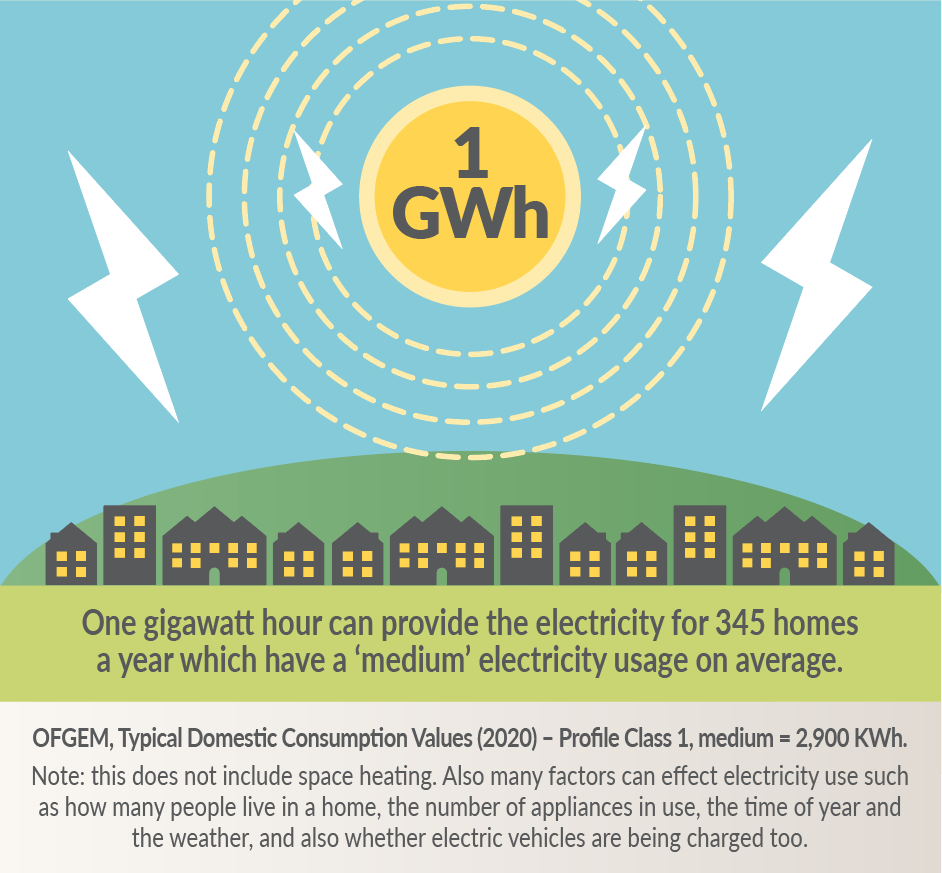
Decarbonising the Grid
A decarbonised energy grid will assist South Gloucestershire meet its and the country’s aim of significantly cutting carbon emissions.
The Government have recently brought forward the target date for the complete decarbonisation of the national grid to 2035, and further work may need to be undertaken to fully understand the implications of this announcement. We do know, however, that for this to be achieved, a significant increase in renewable energy generation (offshore and onshore) is required and renewable energy generation in South Gloucestershire will make an important contribution to this national aim.
Additional land maybe needed to provide new substation, battery storage facilities and infrastructure associated to bring forward a lower carbon energy grid and to enable the new facilities which can generate renewable energy.
What opportunity is there for renewable energy generation in South Gloucestershire?
To inform our new Local Plan, through the RERAS we have undertaken a technical assessment of the opportunities for renewable energy generation in South Gloucestershire.
Through working with our partners (Bath and North East Somerset Council, North Somerset Council and the West of England Combined Authority) we agreed a consistent approach to ‘primary’ constraints, and the areas which they cover were removed from further consideration in the assessment process. The technical assessment was also based on assumptions relating to the outputs required for commercially viable energy development. Information about the process we followed and the results of the technical resource assessment, including the ‘search areas’ (SAs) for wind and solar, are presented in the RERAS.
Other constraints were also looked at and the findings presented for information in the RERAS, and these included the Green Belt, the Cotswolds Area of Outstanding Natural Beauty (AONB) and flood zones. Through the Local Plan process we will need to consider our approach to these constraints in the round alongside other relevant issues, and balance them against the need to significantly increase renewable energy generation. This approach is considered to be consistent with national policy and also that set out in our Local Plan Phase 1 consultation document.
At future stages we will also consider issues relating to landscape sensitivity and cumulative impact. To inform this the RERAS also contains a landscape sensitivity assessment for solar and wind development, as well as an analysis of grid capacity, which will be an important consideration to inform the development of a strategy.
In summary, the theoretical potential for renewable energy generation identified in the RERAS far exceeds the projected local energy demand in 2030. Therefore we have choices and flexibility as we develop the strategy for renewables through the Local Plan process and through this consultation, we are setting out our proposed approach to taking this issue forward and seeking views on it.
General principles
Our evidence illustrates that the issues in relation to how we might develop our approach are different for wind and solar renewable energy generation, and these are discussed below. There are however some general principles, or ‘building blocks’, which we think are an important starting point for developing a positive strategy for renewable energy generation in South Gloucestershire. These are:
- a mix of onshore wind and solar technology is necessary to meet the Climate Emergency 2030 target;
- opportunities to deliver ‘big’ wind energy generation (1MW and 2.5MW turbines) are finite, and therefore they should be safeguarded and utilised due to
- output: 1MW capacity of wind generates over twice as much annual energy output than 1MW capacity of solar PV
- land take: Land is a finite resource, and its efficient use is an important sustainability consideration and a key principle of national planning policy
- 1MW of ground mounted solar PV requires approx. 2 – 2.5 hectares of land. This equates to 3 football pitches. Some farming opportunities, such as grazing, can occur alongside Solar PV (see picture below)
- wind turbines only have the footprint of the turbine itself plus an access road, so there is more scope for farming or other activities to continue around it
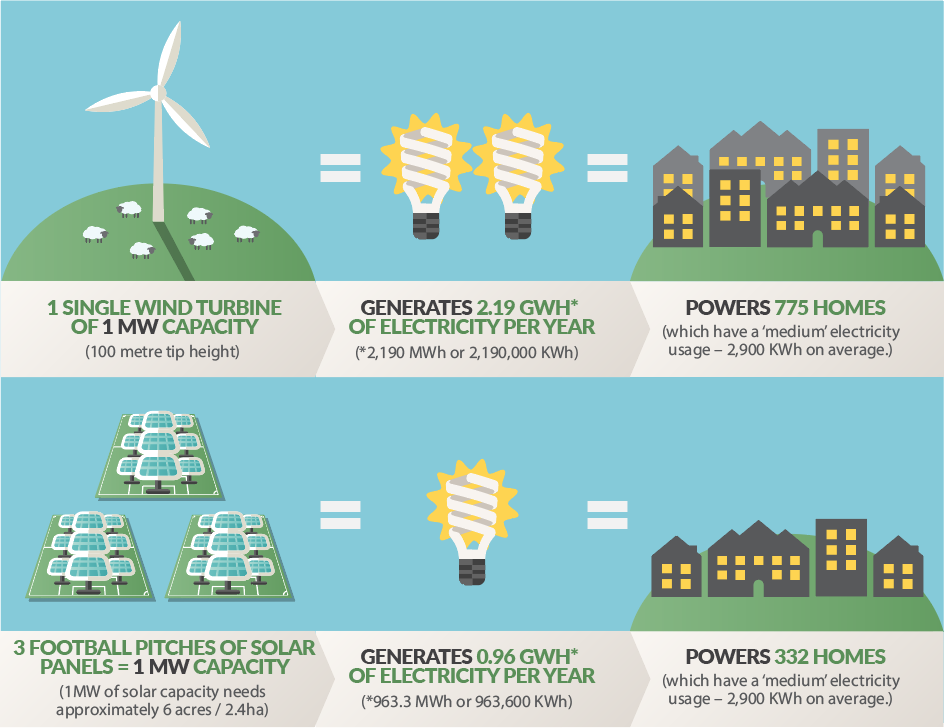
- opportunities for co-location of new renewable energy generation with other complimentary land uses should be explored
- community-led/ community energy proposals should be encouraged
Question
Do you have any comments about the general principles for developing a positive strategy for renewable energy generation in South Gloucestershire?
To answer this question please use our online questionnaire.
Solar energy
Our evidence shows that, as a starting point, large areas of South Gloucestershire are potentially suitable for solar development.
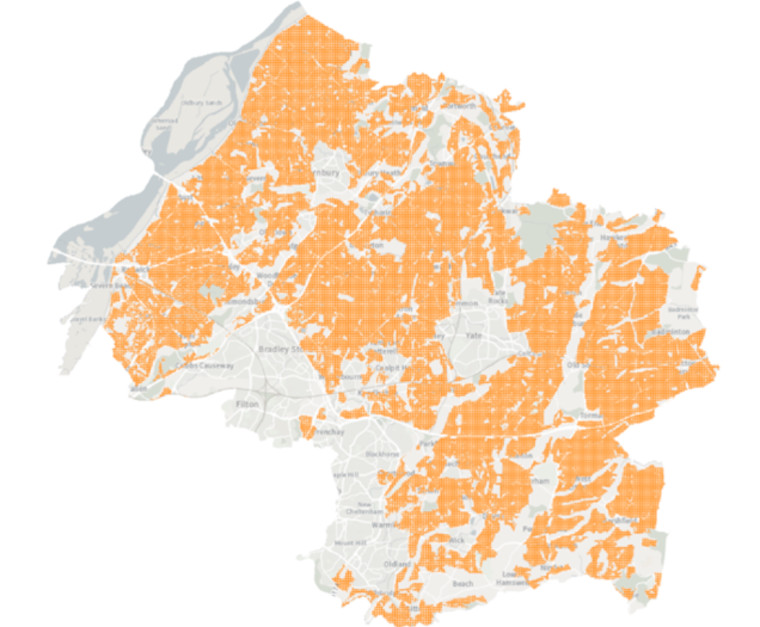
The challenge, therefore, is how we start to ‘refine’ the resource, and so we want to start to focus on areas where we might want to direct development towards (or away from).
With this in mind, we have carried out an initial evaluation of constraints that have not yet been fully considered in defining the ‘search areas’ (see explanatory note for further information). Our current thinking is that the areas covered by the following constraints are removed from further consideration, as this is consistent with our priorities around climate change, nature recovery and, more broadly speaking, environmental protection.
- Natural England Impact Risk Zones for Sites of Special Scientific Interest in relation to solar development
- Agricultural Land Classification Grades 1 and 2*
- Conservation Areas
*It is worth noting that we don’t have data to split Grade 3 into 3a and 3b, but we know that Grade 3 covers circa 70% of South Gloucestershire’s land area. We will need to consider this further in developing our approach going forward, and in the context of other Local Plan objectives and priorities.
The map below shows the remaining potential solar resource after the area covered by these constraints have been removed.
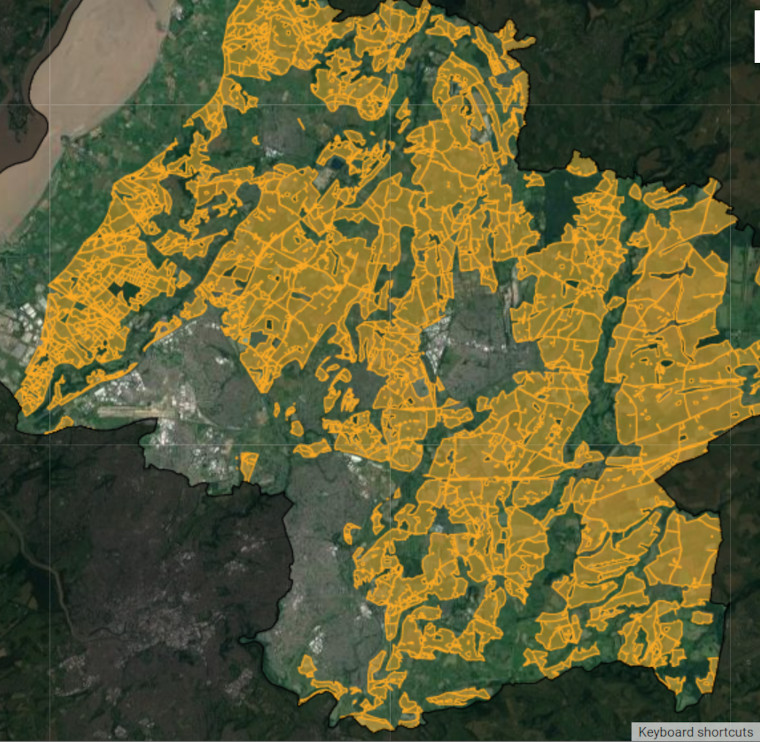
Interactive map of solar renewables
Please note that this is the first stage of consultation on our potential approach to renewable energy. We are seeking your views at this stage and no decisions have yet been made.
The remaining resource area for solar may be refined further through the Local Plan process and we will also need to consider how these areas align with other Local Plan priorities, issues relating to landscape sensitivity, the availability of connections to the national grid and the potential impact of competing or complimentary land uses. For example, we might need to consider how an emerging strategy for solar development could interact positively with the emerging GI network, as research shows that solar PV development can result in enhanced biodiversity.
We will, through future stages of the Local Plan, also seek to develop a positive, robust, criteria-based policy approach to enable the Council to take account of other relevant issues and considerations on a case by case basis as proposals come forward.
Question
Do you have any comments on our proposed approach to solar PV development, or suggestions for other issues we should consider?
To answer these questions please use our online questionnaire.
If you have any land you would like to be considered for this use please complete a Renewables Call for Sites Form.
Wind energy
The RERAS shows that the issues relating to wind energy are quite different to those for solar. As is illustrated on the map below, potential opportunities and areas where wind installations can effectively operate on a commercial basis, shown as search areas, are much more limited.
The RERAS explains how the search areas have been arrived at and presents the resulting search areas for each scale of turbine considered.
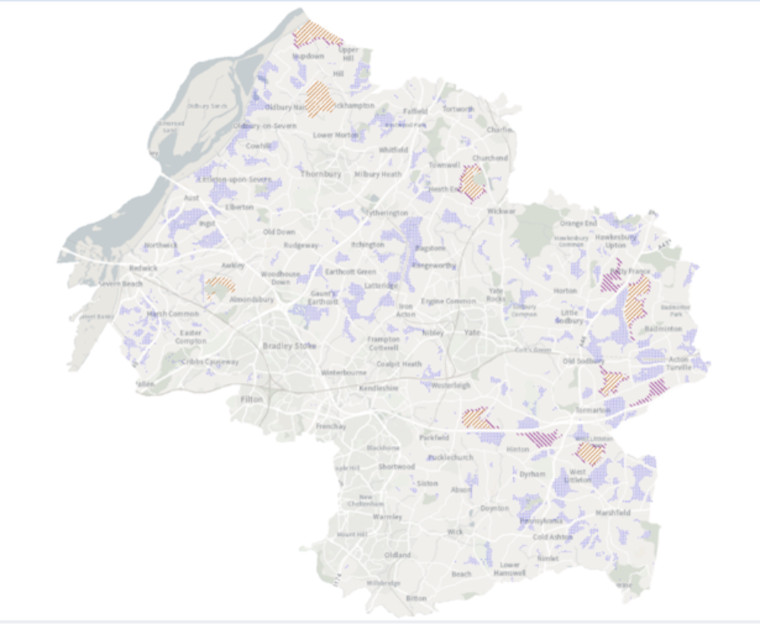
[IKEY (Blue area – 0.5MW turbines; Purple area – 1MW turbines; Orange area – 2.5MW turbines. N.B. some areas overlap.)]
Given the widespread nature of the small (0.5MW) wind opportunities, and bearing in mind the general principles we’ve highlighted above, our initial thinking is that we should safeguard areas for ‘big’ wind energy development (i.e., the 1MW and 2.5MW turbines). These are shown on the map below with a standard buffer in order to prevent sterilisation of the resource opportunity by other land uses, including residential development.
Potential 2.5MW Wind safeguarding areas
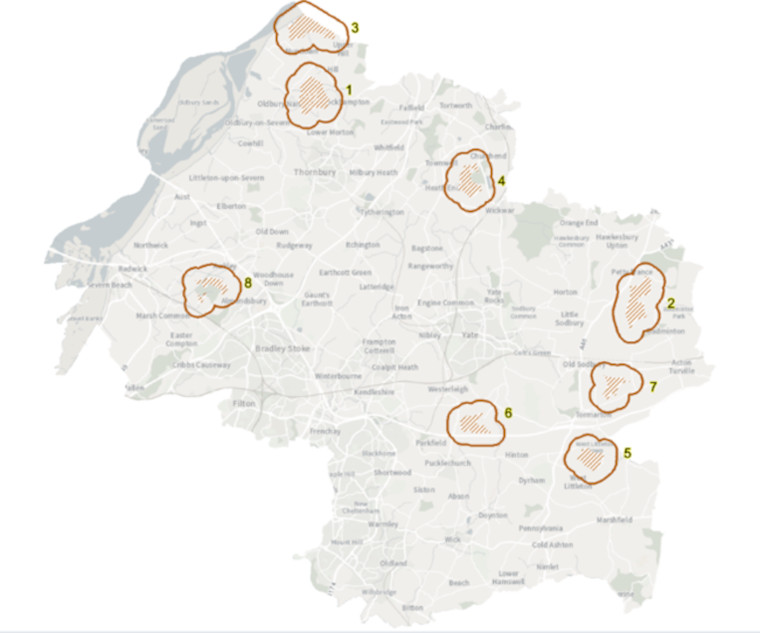
Please note that this is the first stage of consultation on our potential approach to renewable energy. We are seeking your views at this stage and no decisions have yet been made.
| Search Area (SA) reference | SA area (km2) | Potential total installed capacity (MW) |
| 2.5MW-1 | 1.646 | 14.81 |
| 2.5MW-2 | 1.456 | 13.10 |
| 2.5MW-3 | 1.355 | 12.20 |
| 2.5MW-4 | 0.948 | 8.54 |
| 2.5MW-5 | 0.796 | 7.16 |
| 2.5MW-6 | 0.767 | 6.90 |
| 2.5MW-7 | 0.601 | 5.41 |
| 2.5MW-8 | 0.561 | 5.05 |
Potential 1MW Wind safeguarding areas
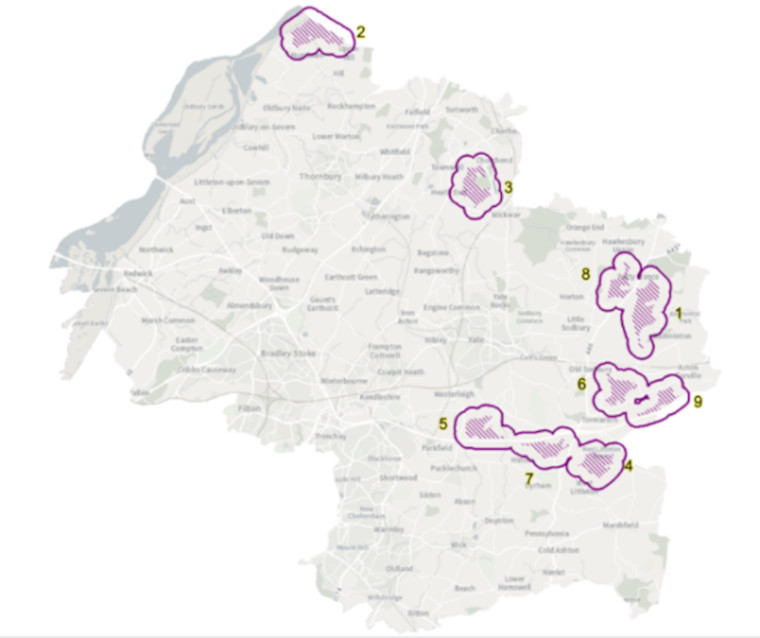
Please note that this is the first stage of consultation on our potential approach to renewable energy. We are seeking your views at this stage and no decisions have yet been made.
| Search Area (SA) reference | SA area (km2) | Potential total installed capacity (MW) |
| 1.0MW-1 | 1.946 | 15.57 |
| 1.0MW-2 | 1.709 | 13.67 |
| 1.0MW-3 | 1.377 | 11.01 |
| 1.0MW-4 | 1.147 | 9.18 |
| 1.0MW-5 | 1.119 | 8.95 |
| 1.0MW-6 | 1.053 | 8.46 |
| 1.0MW-7 | 0.884 | 7.07 |
| 1.0MW-8 | 0.815 | 6.52 |
| 1.0MW-9 | 0.719 | 5.75 |
At this stage, we are not proposing to blanket safeguard land for smaller turbines (i.e., 0.5MW). To be clear, this is not to say that we don’t want to encourage them to come forward, but as they’re a lot more prevalent than the opportunities to bring forward ‘big’ wind (as illustrated above), the land use implications of doing so are much more widespread. This could potentially result in unintended consequences in terms of sterilising land for other uses.
We do however think that, if communities or developers highlight proposals for smaller turbines to come forward through the Local Plan process, we could consider the potential to safeguard specific areas of land to facilitate the delivery of those proposals.
Going forward we will need to consider how safeguarding areas for wind energy development aligns with other Local Plan priorities, the potential impacts of competing or complimentary land uses, issues relating to landscape sensitivity and also the availability of connections to the national grid.
Question
Do you have any comments on our proposed approach and areas suggested for safeguarding ‘big wind’?
To answer these questions please use our online questionnaire.
If you have any land you would like to be considered for this use please complete a Renewables Call for Sites Form.
Community energy proposals
As explained above, the assumptions made in our evidence relate to the levels of energy output likely to be required to bring forward commercially driven proposals. It may however be that community groups or some developers may wish to pursue proposals with a lower energy output.
Community initiatives are likely to play an increasingly important role and should be encouraged as a way of providing positive local benefit from renewable energy development. Further information for communities interested in developing their own initiatives is available from the following organisations:
And government guidance on Community Energy published by the Department for Business, Energy and Industrial Strategy (BEIS) is available.
Through preparing our Local Plan, we would like to develop a policy framework which gives positive weight to renewable and low carbon energy initiatives which have clear evidence of local community involvement and leadership.
We are also keen to support communities in bringing forward their own energy proposals and see this as an important part of developing our approach to renewable energy. As part of this, we are keen to enable communities to realise the positive benefits that such schemes can bring locally, as well as the contribution they can make to our wider objectives around climate change.
Question
Do you have any comments on our proposed approach to community energy proposals?
Do you know of or represent a local community group with an interest in energy generation? If so, what measures would you like to see put in place to support you to bring forward proposals?
To answer these questions please use our online questionnaire.
Read the next chapter – Strategic Green Infrastructure Network
Go back to the Local Plan 2020 – Phase 2 Urban, Rural and Key Issues document landing page.